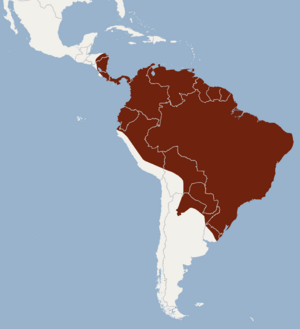Riparian myotis facts for kids
Quick facts for kids Riparian myotis |
|
|---|---|
| Conservation status | |
| Scientific classification | |
| Genus: |
Myotis
|
| Species: |
riparius
|
 |
|
The riparian myotis (Myotis riparius) is a type of bat that lives in South and Central America. It belongs to a family of bats called vesper bats. This bat is a medium-sized bat compared to other South American bats in the Myotis group.
Contents
What is a Riparian Myotis?
The riparian myotis was first described in 1960. At that time, scientists thought it was a type of velvety myotis. But in 1973, after more study, they decided it was different enough to be its own unique species.
How to Spot a Riparian Myotis
The riparian myotis has long, soft fur. The fur on its back (called dorsal fur) can be reddish or even blackish, depending on where the bat lives. Bats in the southern parts of their range often have darker fur, while those in the north tend to be more reddish. The hairs on their back are all one color.
Their wing membrane (called the plagiopatagium) connects broadly to their foot, right at the base of their toes. Their ears are quite short compared to their eyes and nose. Inside their ear, there's a small, pointed part called the tragus that curves slightly outwards.
The fur on their belly (called ventral fur) has two colors: a dark-brown base with yellowish tips.
Where Riparian Myotis Bats Live
The M. riparius bat is found across a large area of the neotropical region. This means you can find them from Honduras all the way south to Paraguay, northern Argentina, and Uruguay.
These bats can live in many different places, including rainforests, savannas (which are like grasslands with scattered trees), and other open areas. They are most often seen from sea level up to 2,000 meters high. They have even been spotted in open grasslands and farm fields.
Riparian myotis bats usually prefer old, untouched forests and places where their natural habitat is protected. They have been seen resting (or roosting) under tree bark and inside caves. Sometimes, they share their roosting spots with other bat species, like the black myotis, Silver-tipped myotis, and Velvety free-tailed bat. These bats can form groups, or colonies, with up to 50 other bats.
See also
 In Spanish: Murciélago ribereño para niños
In Spanish: Murciélago ribereño para niños


